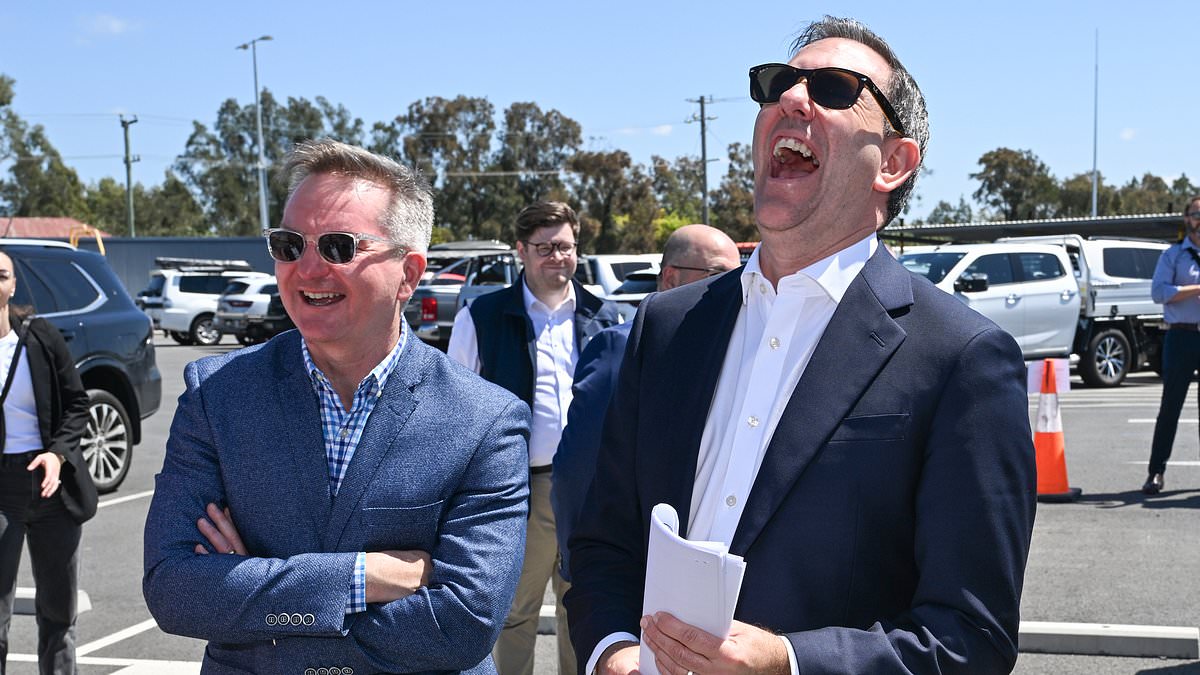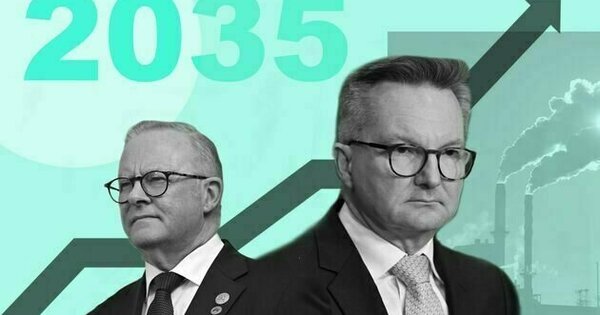PETER VAN ONSELEN: The big lie every Australian is being told about our net zero climate change target… as painfully staged photos show Bowen and Chalmers having a right old laugh
By Editor,Peter van Onselen
Copyright dailymail

Today Labor’s cabinet will meet to decide what 2035 emissions reduction target it will commit Australia to for the coming decade.
When I say ‘commit’, I really mean announce – because the chances of successfully achieving the target are nigh on impossible.
It will be somewhere between 60 per cent reductions on 2005 emissions levels and 75 per cent.
Business is pushing for the more modest goal. Environmentalists say 60 per cent doesn’t go nearly far enough.
But here is the uncomfortable truth about Australia’s climate targets: the politics is winning, the maths is losing.
The targets in the frame – especially the net zero by 2050 goal already announced – are as unlikely to be met as Bob Hawke’s famous ‘no child will be living in poverty by 1990’ promise made at Labor’s 1987 election launch.
Thirty-five years on from when that KPI wasn’t met, it still hasn’t been, because it’s as unrealistic now as it was back then. It has long since been abandoned.
The net zero goal is no better.
When it comes to emissions targets, Labor has already fudged the numbers.
When anyone promises to reduce emissions by whatever percentage, they have to peg that pledged reduction to a moment in time.
It used to be what we emitted in the year 2000. But after Labor was elected in 2022, it changed it to 2005 emissions levels.
That’s called moving the goal posts.
It makes the target sound the same, but it is actually a substantially lower threshold, because 2005 emission levels were substantially higher than those of 2000.
If nothing else, it’s sneaky. It creates a nice headline – but we still aren’t achieving the goal.
Successive governments have treated the baseline year like a public relations variable.
The Climate Change Authority’s own records show how the original 2020 target was framed off 2000 levels, before the 2005 baseline became the norm for 2030 and the Climate Change Act that is now in place.
The 2030 target is a 43 per cent reduction (on 2005 levels), which, five years from now, almost certainly won’t be achieved.
Neither will whatever Labor announces after its cabinet meeting.
As for the net zero target for 2050, because that’s not even pegged against 2005 levels, it’s completely unrealistic – unless yet-to-be invented technologies change the game entirely.
Net zero means that by 2050, the amount of greenhouse gases Australia emits into the atmosphere must be fully balanced by the amount removed (through offsets, carbon capture, reforestation and so on), so that Australia’s net contribution is zero.
Even if Australia somehow achieved what gets promised for 2035, the jump required to get to net zero just 15 years later is utterly absurd.
Even judged on the government’s chosen (and sneaky) shifted 2005 baseline, it is difficult to deliver.
The latest official projections show Australia landing just shy of our legislated 2030 target of 43 per cent.
In raw numbers that means getting from roughly 440 megatonnes of emissions in the year to March 2025 to about 350 by 2030: a 90 megatonne reduction in just five years.
With known grid, transmission and industry bottlenecks that is a heroic assumption at best, yet today, an even less realistic 2035 goal will be agreed to.
The Climate Change Authority has advised that a cut of between 65 and 75 per cent below 2005 levels is necessary (for exactly what, we will come to shortly).
However, the government’s own projections only have us achieving 51 per cent by 2035.
So unless we get radical and find painful ways to force higher reductions via more taxes, inflated energy prices to discourage usage and forced closure of energy-intensive industries (meaning significant job losses), whatever gets announced for 2035 will be nothing more than vacuous political posturing because it just won’t happen.
Targets are easy, industrial transformation and changing consumer habits certainly are not.
And then we circle back to the net zero 2050 target. It’s already legislated, yes. But legislating the destination without hardwiring the waypoints and the penalties to get there onto the economy is meaningless.
The Act codifies the goals and the annual statements, but it doesn’t guarantee delivery when the hardest cuts to heavy industry, agriculture and long-haul transport bite.
The politicians who are trumpeting success today will all be retired by the time the due date arrives anyway, which is precisely why they are happy to make the commitment without putting policy meat on its bones to actually make it happen.
I believe in climate action. I’m not a so-called ‘climate change denier’, a label that often gets used to shut down critics who raise legitimate questions about the religious fervour attached to all these lofty targets.
But the present conversation is heavy on spin and light on means, and it deserves to get called out. Also, where is the necessary mitigation funding in the event climate change can’t be stopped?
Surely from a risk management perspective, that needs to get far more attention if we are serious about planning for the consequences of climate change? Even if reduction targets get met, and met globally, scientists tell us global warming is now unavoidable.
Ministers like to point to a faster take up of renewables and an 82 percent ‘on-grid target’ alongside vehicle efficiency standards as evidence we’ll make it happen. Officials add that we are close to achieving the 2030 goal.
But close means we are still falling short of it, and the promises for five years later and 15 years after that require an acceleration in emissions reductions policy changes that just aren’t locking in.
To align policy needs to achieve the targets with what gets announced would require such radical action that if voters knew how that’s likely to impact their daily lives they would never sign up to it.
Which is probably why the policy work to get there never happens.
There’s also the question too many advocates want to avoid, the one I said we would circle back to: what would it even matter globally if Australia somehow did achieve its targets – despite the heavy economic costs attached to doing so?
Treasury’s Intergenerational Report recognises climate change as a structural force with significant economic impacts no matter what we do. Action has costs, inaction has bigger ones.
But action that’s inflated beyond what the national economy and consumers and businesses can tolerate probably has costs every bit as significant as inaction.
And if the global community doesn’t all do the same thing – in particular the big-population, big-emitting countries – it’s all for nothing anyway.
Currently 31 countries have announced 2035 emissions reduction targets, we are set to be the 32nd. But only two have released targets consistent with limiting global warming to 1.5 degrees.
One is Norway with a population of just 5.8 million. The other is the UK, which won’t get there anyway. Neither will most of the remaining nations with announced targets, especially the big emitters, and many of them don’t even have targets.
In fact, their emissions are growing not going down, because they are developing countries with burgeoning middle classes consuming more as their wealth and quality of lives improve.
When it comes to reducing emissions to create meaningful global emissions cuts, scale matters. Australia’s share of global carbon emissions is at most 1.3 per cent. On a per capita basis it’s on the higher side, which is why doing nothing isn’t acceptable.
But whatever we do doesn’t matter if the big population centres aren’t also taking meaningful action.
What happens in the US, China, India and the EU will decide the planet’s fate. That doesn’t absolve us of responsibility, of course, but it does mean we should resist the theatre of ever larger targets, unmoored from executable plans.
When climate change minister Chris Bowen tries to claim that ‘every action we take today towards our goal of net zero by 2050 will help avoid the worst impacts on Australian communities and businesses’, as he did this week, he has to know that’s ridiculous.
What Australia does or doesn’t do by itself won’t avoid anything.
If the major emitters do not move fast enough, Australia hitting a 60 or 75 or even a 100 per cent reduction on 2005 levels by 2035 will barely register in the climate ledger.
And even if all of a sudden the big global players do move, we still owe it to the public to make our transition efficient, durable and honest about the trade-offs doing so requires.
The baseline shuffle, shifting the year we peg our reductions to from 2000 to 2005, helped politicians talk bigger numbers while really just doing much the same thing. It speaks powerfully to what really matters to them: the optics of appearing to take stronger action rather than actually doing so.
The new 2035 target risks repeating this cycle: picking a number to sound bold, then daring the next government to bridge the gap. And let’s face it, Labor also wants to use climate change action as a political wedge to maintain its dominance over the Coalition.
The opposition is making that easier via its own internal disagreements, and it has certainly also played politics with this issue, but that doesn’t absolve Labor of the same charge.
If we are serious we should judge policy by deliverables, not the blow hard decibels political rhetoric can reach. And let’s finally stop pretending that setting a target is the same as meeting it.
Dr Peter van Onselen is a professor of public policy at the University of Western Australia.



